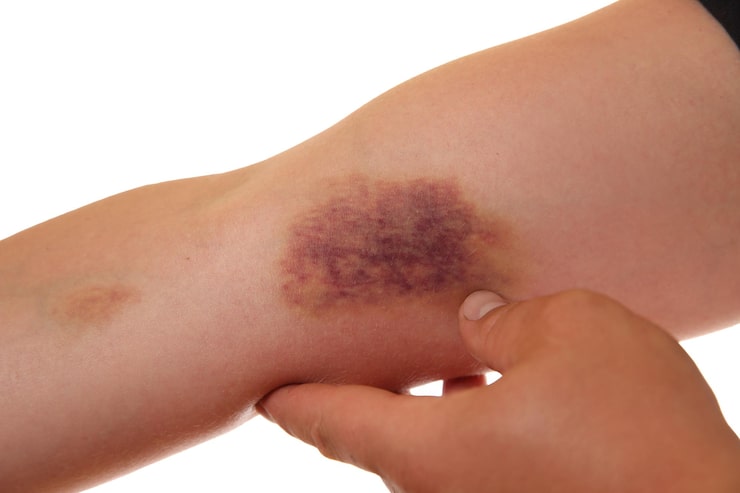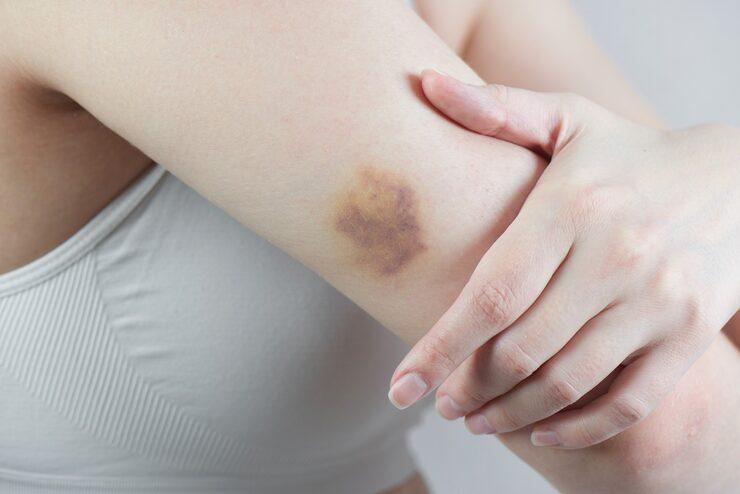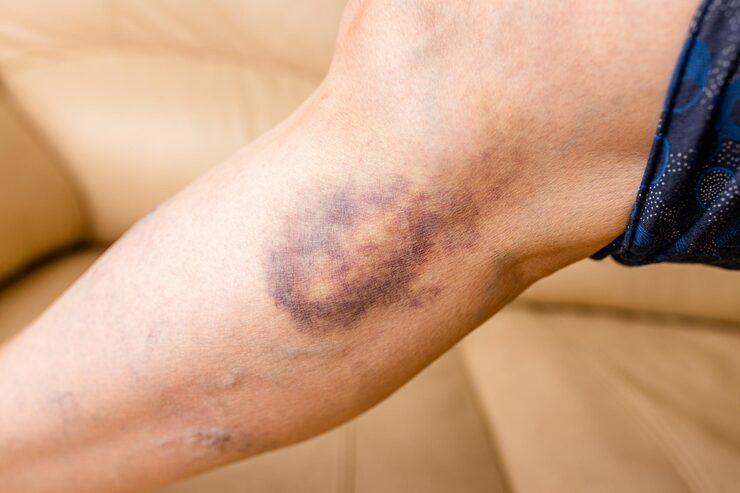
hematoma on the arm of a person
It's common to experience some bruising or swelling after an injury or surgery. However, if blood accumulates under the skin or in deeper tissues, it can lead to a hematoma, a more serious condition that requires close monitoring and treatment.
When blood leaks out of broken blood vessels and collects in the surrounding tissues, it causes a hematoma, a lump or swelling. Many small hematomas resolve on their own; however, if not treated effectively, larger or deeper ones may cause discomfort, put pressure on surrounding tissues, and lead to complications.
Our doctors, surgeons, and radiologists at Prakash Hospital in Noida are well-qualified and experienced in treating all types of hematomas, ranging from minor accidents to severe cases of internal bleeding.
This blog post discusses hematomas, their various types, symptoms, treatment options, and when to seek medical attention.
A hematoma is a collection of blood that isn't in blood vessels. When a blood vessel is injured, the blood doesn't stay in the circulatory system; it leaks into adjacent tissues.
Hematomas are not the same as normal bruises, as they typically involve larger blood vessels, which exacerbates the swelling, discomfort, and color changes. Over time, the body progressively reabsorbs the blood that has been trapped; however, in some cases, doctors may need to intervene to prevent infection or tissue damage.
Hematomas can occur anywhere in the body, including under the skin, in muscles, and even within organs such as the brain. A few common groups are:
1. A hematoma beneath the skin
It forms just under the skin following an injury.
It hurts and looks like a red, purple, or swollen spot.
2. A hematoma in the muscle
It usually occurs after a significant bruising or strain on a muscle.
It makes you stiff, hurts, and stops you from moving.
3. A bruise under the nail
It happens under the nail bed of a finger or toe when something crushes it.
It makes people sad, aches, and stresses them out.
4. Hematoma in the ear
It appears on the outside of the ear and is more common in boxers and wrestlers.
Needs must be taken care of right away to avoid permanent damage, which is known as "cauliflower ear."
5. Hematoma in the Septum
It happens inside the nose following an injury.
If you don't receive treatment, it may make it difficult to breathe and damage the cartilage.
6. Blood clots in the gaps between the epidural and subdural layers
The form between the brain and the membranes that protect it inside the skull.
They are medical emergencies that can kill you and are often induced by head injuries
7. A hematoma in the stomach or an organ
Blood gathers in or around organs such as the liver, kidneys, or spleen.
Most of the time, this happens after an injury or surgery.

hematoma on someone’s arm
Several variables can contribute to the formation or exacerbation of a hematoma.
1. Harm to the body
Falling, getting hit, getting into a car accident, or getting hurt while playing sports are the most common causes of blood vessel rupture.
2. Operations
Bleeding from surgical sites after surgery can lead to the formation of hematomas either internally or externally.
3. Medicines that thin the blood
If you use drugs like aspirin, warfarin, or anticoagulants, you are more likely to bleed even if you only have a small cut.
4. Issues with health
People who have bleeding problems like hemophilia or liver illness are more likely to have hematomas.
5. Getting an injection or using a catheter
After getting an IV or shot, blood may collect under the skin.
6. A hematoma that happens by itself
Hematomas can occur even without a clear injury; however, this is quite rare. People with weak blood vessels or difficulties clotting are more prone to have it.
Anyone can get a hematoma, although some people are more likely to get one than others:
Before prescribing treatment to prevent the problem from recurring, the experts at Prakash Hospital in Noida thoroughly review each patient's medical history, medications, and risk factors.
Some signs that you might have a hematoma are:
We strive to determine the size, depth, and origin of the hematoma at Prakash Hospital, so that we can plan the most effective treatment.
1. A physical exam
Doctors check for swelling, color, and pain to see whether there is an infection or pressure.
2. Tests using images
Ultrasound: Detects fluid accumulation beneath the skin or within muscles.
CT scans and MRIs look for hematomas that are deeper or located inside the body, such as those in the brain or abdomen.
X-rays can reveal shattered bones or other types of bone damage.
3. Blood tests
Look for signs of anemia, infection, or blood clotting issues.

hematoma on a person
The location, size, and severity of the hematoma will determine the treatment approach. Some go away on their own, but others need medical or surgical help.
1. Conservative Treatment (for Mild Cases)
Rest: Don't do things that could make the bleeding worse.
Ice therapy: To ease discomfort and swelling, put ice packs on for 15 to 20 minutes every few hours.
Compression: Light bandaging may help stop more bleeding.
Elevation: Lifting the hurt limb helps it swell less.
Pain Relief: Take over-the-counter medicines, but stay away from blood thinners like aspirin.
Hematomas that are small and not too deep normally go away on their own in 1 to 2 weeks.
2. Medical Management
Drainage or Aspiration: If the hematoma is big or putting pressure on something, doctors may use a clean needle or a small cut to drain the blood.
Antibiotics: Given if there is a chance of infection.
Correction of blood coagulation: Patients with bleeding issues may be given clotting factors or vitamin K.
3. Surgery (for serious cases)
Leaving Surgery: Needed when the hematoma puts pressure on the brain, nerves, or organs.
Reconstruction or cauterization is done to fix damaged blood vessels and keep them from happening again.
4. Treatment for Certain Types
Subungual Hematoma: Using a sterile procedure to drain via the nail improves discomfort and pressure.
Auricular or Septal Hematoma: Immediate drainage stops the nose from becoming misshapen or blocked.
Neurosurgeons perform craniotomy or burr hole drainage to relieve pressure on the brain in cases of intracranial hematoma.
Our surgical and emergency care specialists at Prakash Hospital in Noida have access to modern imaging, minimally invasive drainage procedures, and 24/7 monitoring to make sure that patients heal quickly and with as little scarring as possible
If you don't pay attention to a hematoma, it could cause major problems like infection and abscess formation.
Death of skin or muscular tissue (tissue necrosis)
Calcification or making the clot harder
Pain or numbness caused by nerve compression
Organ malfunction (if bleeding inside the body keeps happening)
Getting checked out by professionals early on can help avoid these problems and speed up recuperation.
With the right care and rest, most people get better completely. The size and location of the hematoma affect how long it takes to heal. Smaller ones may recover in a few days, but bigger or interior ones may take weeks.
It is vitally important to follow medical instructions, avoid getting hurt again, and go to follow-up visits to make sure you fully recover.
Wear protective gear when you play sports or do other physical activities to lower your risk of getting hematomas.
Our physicians at Prakash Hospital use the latest diagnostic equipment and the least invasive treatments to give full care to hematomas and their complications.
Radiologists, trauma surgeons, neurologists, and physiotherapists are all part of our multidisciplinary approach. This makes sure that each patient gets the right care for their needs.
Go to Prakash Hospital in Noida for expert examination and care if you notice any odd swelling, discoloration, or pain after an injury or operation. Early diagnosis and treatment can prevent problems from getting worse and help you get back to normal activities quickly.
We offer expert care across key specialties, including Medicine, Cardiology, Orthopaedics, ENT, Gynaecology, and more—delivering trusted treatment under one roof.
Prakash Hospital Pvt. Ltd. is a 100 bedded NABH NABL accredited multispecialty hospital along with a center of trauma and orthopedics. We are in the service of society since 2001.
OUR SPECIALITIES
Contact Us
D – 12A, 12B, Sector-33, G. B. Nagar, Noida, Uttar Pradesh 201301
+91-8826000033

© 2025 All rights reserved.
Designed and Developed by Zarle Infotech